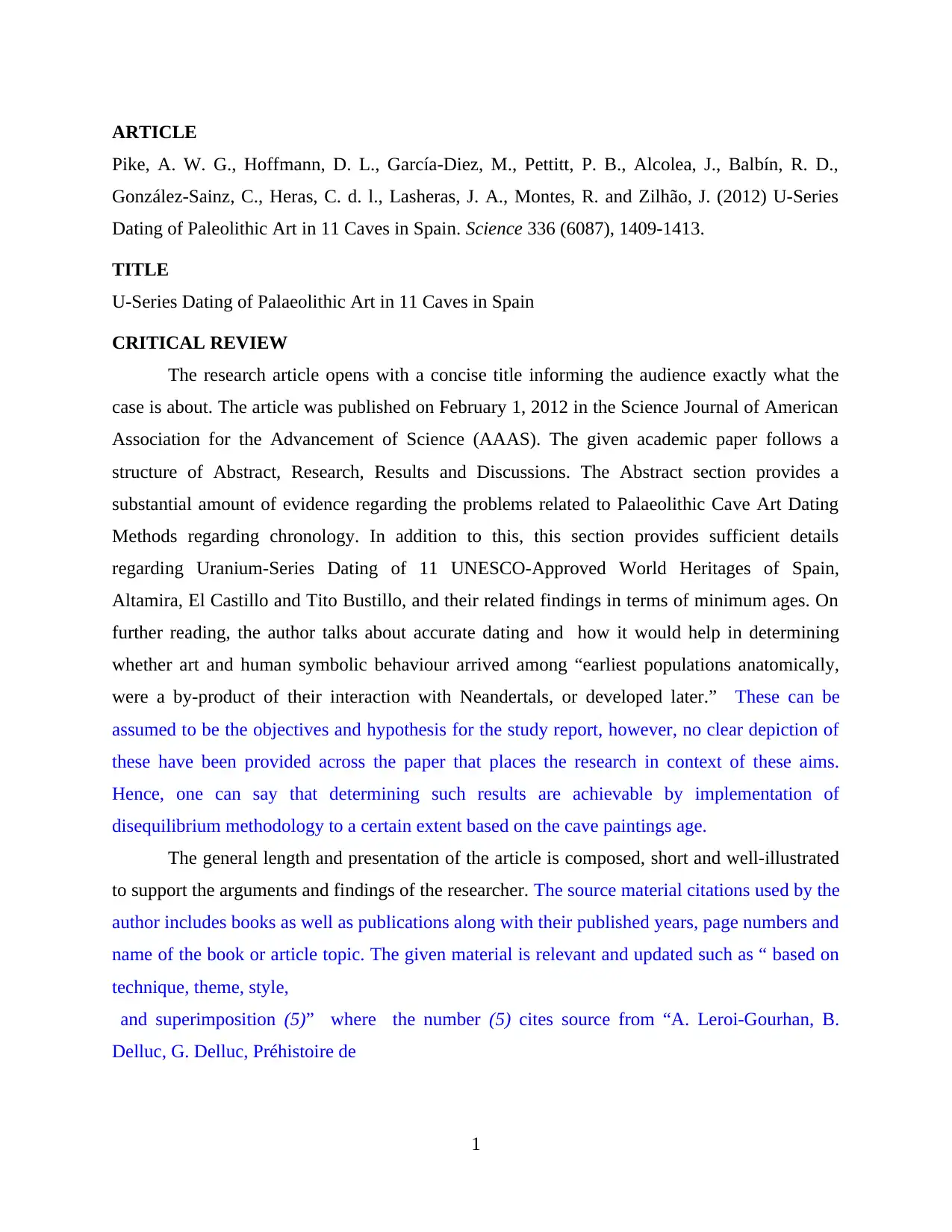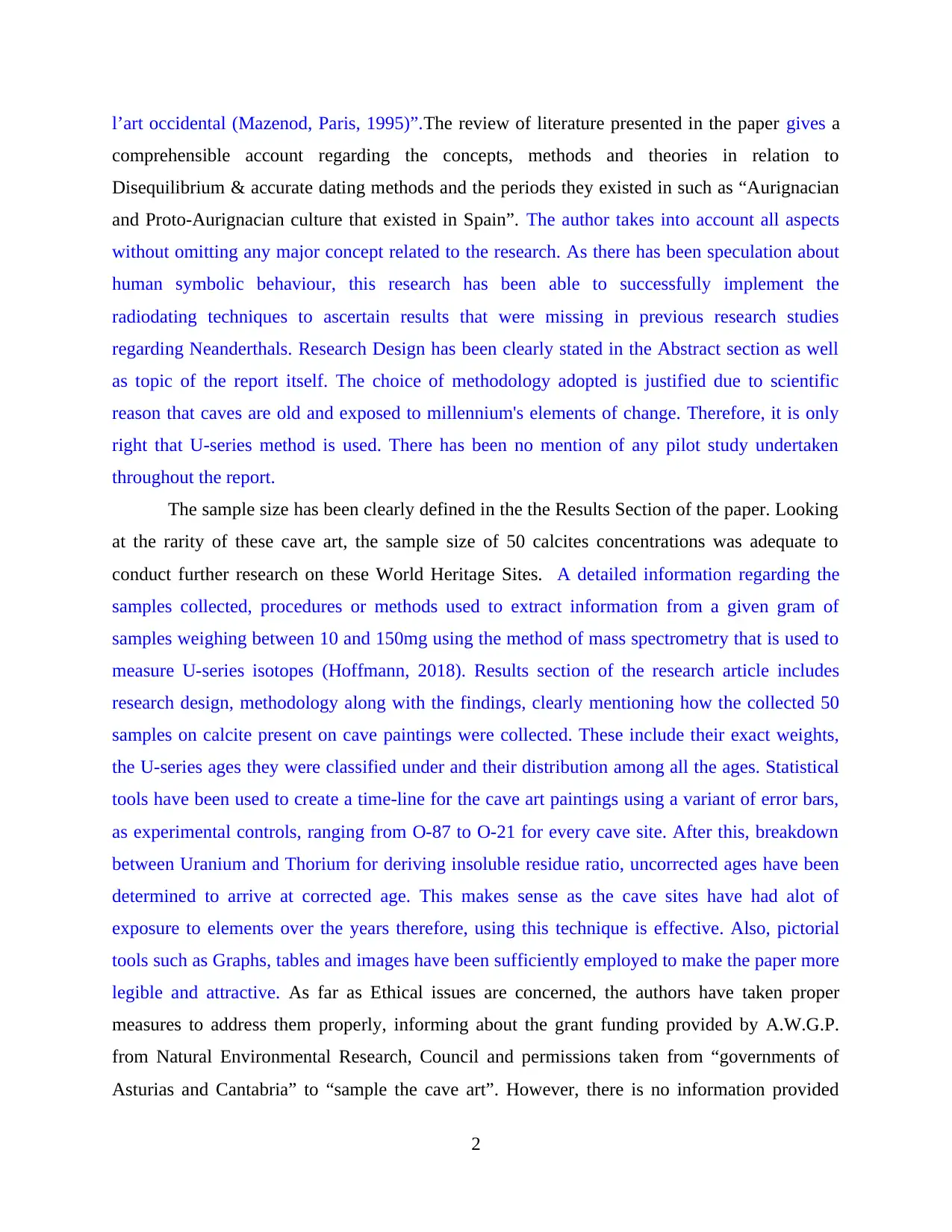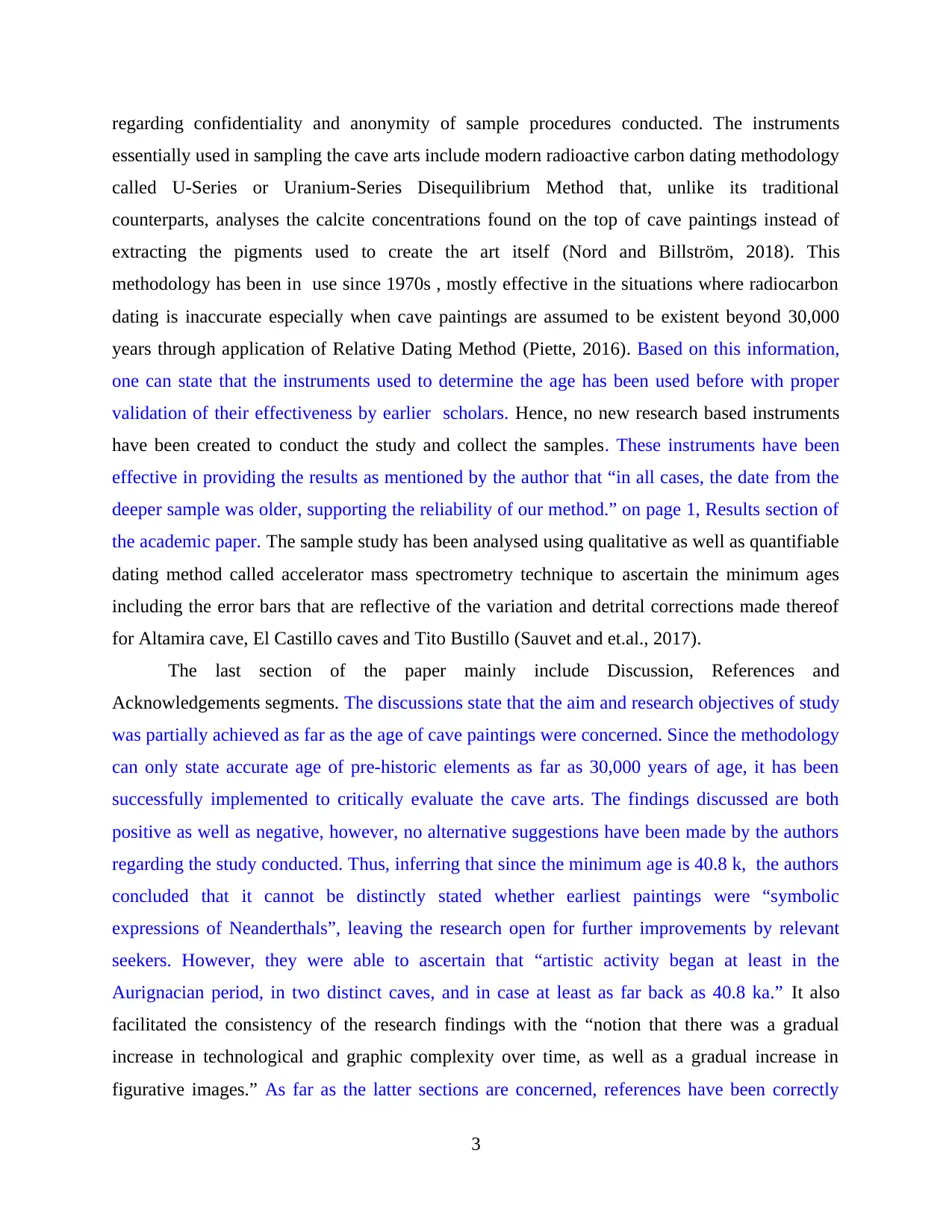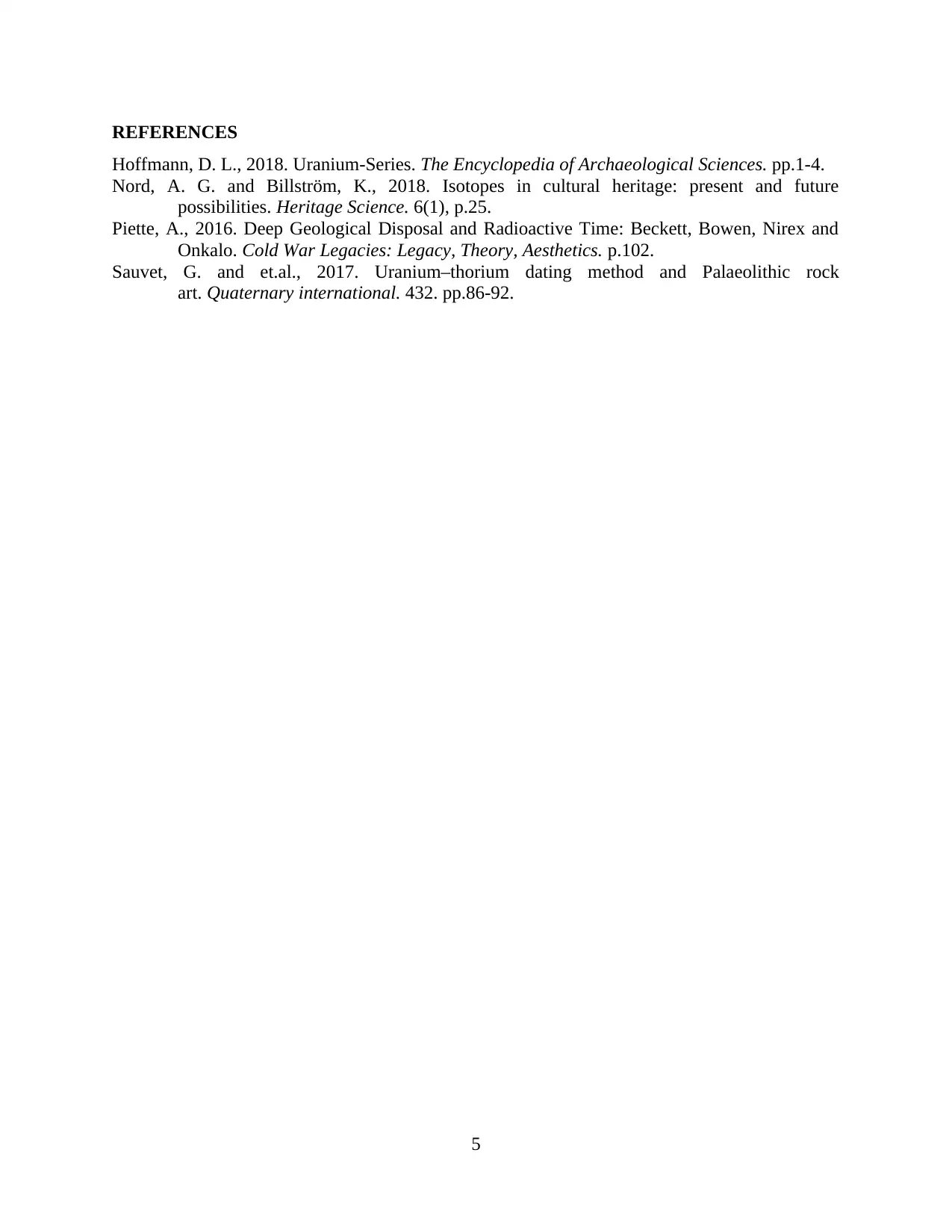Critical Review of 'U-Series Dating of Palaeolithic Art' Research
VerifiedAdded on 2021/01/11
|7
|1532
|46
Report
AI Summary
This report presents a critical review of the research article titled 'U-Series Dating of Palaeolithic Art in 11 Caves in Spain,' published in Science. The review examines the article's structure, including the abstract, research design, results, and discussion. It highlights the use of Uranium-Series dating to determine the age of cave paintings in Spanish UNESCO World Heritage sites, such as Altamira and El Castillo. The review analyzes the methodology, sample size, and statistical tools employed, emphasizing the ethical considerations and instruments used. The report also discusses the findings related to the minimum ages of cave paintings, the consistency of results with previous research, and the implications for understanding the origins of human symbolic behavior. The review concludes by summarizing the article's strengths and limitations, providing a comprehensive overview of the research and its contribution to the field of archaeology. The report is designed to provide students with a comprehensive analysis of the research paper, covering all major aspects of the study, including the methodology, findings, and implications for the field of archaeology. The report is available on Desklib, a platform for students to access past papers and solved assignments.

CRITICAL REVIEW
Paraphrase This Document
Need a fresh take? Get an instant paraphrase of this document with our AI Paraphraser

Table of Contents
ARTICLE.........................................................................................................................................1
TITLE..............................................................................................................................................1
CRITICAL REVIEW.......................................................................................................................1
REFERENCES................................................................................................................................5
ARTICLE.........................................................................................................................................1
TITLE..............................................................................................................................................1
CRITICAL REVIEW.......................................................................................................................1
REFERENCES................................................................................................................................5

ARTICLE
Pike, A. W. G., Hoffmann, D. L., García-Diez, M., Pettitt, P. B., Alcolea, J., Balbín, R. D.,
González-Sainz, C., Heras, C. d. l., Lasheras, J. A., Montes, R. and Zilhão, J. (2012) U-Series
Dating of Paleolithic Art in 11 Caves in Spain. Science 336 (6087), 1409-1413.
TITLE
U-Series Dating of Palaeolithic Art in 11 Caves in Spain
CRITICAL REVIEW
The research article opens with a concise title informing the audience exactly what the
case is about. The article was published on February 1, 2012 in the Science Journal of American
Association for the Advancement of Science (AAAS). The given academic paper follows a
structure of Abstract, Research, Results and Discussions. The Abstract section provides a
substantial amount of evidence regarding the problems related to Palaeolithic Cave Art Dating
Methods regarding chronology. In addition to this, this section provides sufficient details
regarding Uranium-Series Dating of 11 UNESCO-Approved World Heritages of Spain,
Altamira, El Castillo and Tito Bustillo, and their related findings in terms of minimum ages. On
further reading, the author talks about accurate dating and how it would help in determining
whether art and human symbolic behaviour arrived among “earliest populations anatomically,
were a by-product of their interaction with Neandertals, or developed later.” These can be
assumed to be the objectives and hypothesis for the study report, however, no clear depiction of
these have been provided across the paper that places the research in context of these aims.
Hence, one can say that determining such results are achievable by implementation of
disequilibrium methodology to a certain extent based on the cave paintings age.
The general length and presentation of the article is composed, short and well-illustrated
to support the arguments and findings of the researcher. The source material citations used by the
author includes books as well as publications along with their published years, page numbers and
name of the book or article topic. The given material is relevant and updated such as “ based on
technique, theme, style,
and superimposition (5)” where the number (5) cites source from “A. Leroi-Gourhan, B.
Delluc, G. Delluc, Préhistoire de
1
Pike, A. W. G., Hoffmann, D. L., García-Diez, M., Pettitt, P. B., Alcolea, J., Balbín, R. D.,
González-Sainz, C., Heras, C. d. l., Lasheras, J. A., Montes, R. and Zilhão, J. (2012) U-Series
Dating of Paleolithic Art in 11 Caves in Spain. Science 336 (6087), 1409-1413.
TITLE
U-Series Dating of Palaeolithic Art in 11 Caves in Spain
CRITICAL REVIEW
The research article opens with a concise title informing the audience exactly what the
case is about. The article was published on February 1, 2012 in the Science Journal of American
Association for the Advancement of Science (AAAS). The given academic paper follows a
structure of Abstract, Research, Results and Discussions. The Abstract section provides a
substantial amount of evidence regarding the problems related to Palaeolithic Cave Art Dating
Methods regarding chronology. In addition to this, this section provides sufficient details
regarding Uranium-Series Dating of 11 UNESCO-Approved World Heritages of Spain,
Altamira, El Castillo and Tito Bustillo, and their related findings in terms of minimum ages. On
further reading, the author talks about accurate dating and how it would help in determining
whether art and human symbolic behaviour arrived among “earliest populations anatomically,
were a by-product of their interaction with Neandertals, or developed later.” These can be
assumed to be the objectives and hypothesis for the study report, however, no clear depiction of
these have been provided across the paper that places the research in context of these aims.
Hence, one can say that determining such results are achievable by implementation of
disequilibrium methodology to a certain extent based on the cave paintings age.
The general length and presentation of the article is composed, short and well-illustrated
to support the arguments and findings of the researcher. The source material citations used by the
author includes books as well as publications along with their published years, page numbers and
name of the book or article topic. The given material is relevant and updated such as “ based on
technique, theme, style,
and superimposition (5)” where the number (5) cites source from “A. Leroi-Gourhan, B.
Delluc, G. Delluc, Préhistoire de
1
⊘ This is a preview!⊘
Do you want full access?
Subscribe today to unlock all pages.

Trusted by 1+ million students worldwide

l’art occidental (Mazenod, Paris, 1995)”.The review of literature presented in the paper gives a
comprehensible account regarding the concepts, methods and theories in relation to
Disequilibrium & accurate dating methods and the periods they existed in such as “Aurignacian
and Proto-Aurignacian culture that existed in Spain”. The author takes into account all aspects
without omitting any major concept related to the research. As there has been speculation about
human symbolic behaviour, this research has been able to successfully implement the
radiodating techniques to ascertain results that were missing in previous research studies
regarding Neanderthals. Research Design has been clearly stated in the Abstract section as well
as topic of the report itself. The choice of methodology adopted is justified due to scientific
reason that caves are old and exposed to millennium's elements of change. Therefore, it is only
right that U-series method is used. There has been no mention of any pilot study undertaken
throughout the report.
The sample size has been clearly defined in the the Results Section of the paper. Looking
at the rarity of these cave art, the sample size of 50 calcites concentrations was adequate to
conduct further research on these World Heritage Sites. A detailed information regarding the
samples collected, procedures or methods used to extract information from a given gram of
samples weighing between 10 and 150mg using the method of mass spectrometry that is used to
measure U-series isotopes (Hoffmann, 2018). Results section of the research article includes
research design, methodology along with the findings, clearly mentioning how the collected 50
samples on calcite present on cave paintings were collected. These include their exact weights,
the U-series ages they were classified under and their distribution among all the ages. Statistical
tools have been used to create a time-line for the cave art paintings using a variant of error bars,
as experimental controls, ranging from O-87 to O-21 for every cave site. After this, breakdown
between Uranium and Thorium for deriving insoluble residue ratio, uncorrected ages have been
determined to arrive at corrected age. This makes sense as the cave sites have had alot of
exposure to elements over the years therefore, using this technique is effective. Also, pictorial
tools such as Graphs, tables and images have been sufficiently employed to make the paper more
legible and attractive. As far as Ethical issues are concerned, the authors have taken proper
measures to address them properly, informing about the grant funding provided by A.W.G.P.
from Natural Environmental Research, Council and permissions taken from “governments of
Asturias and Cantabria” to “sample the cave art”. However, there is no information provided
2
comprehensible account regarding the concepts, methods and theories in relation to
Disequilibrium & accurate dating methods and the periods they existed in such as “Aurignacian
and Proto-Aurignacian culture that existed in Spain”. The author takes into account all aspects
without omitting any major concept related to the research. As there has been speculation about
human symbolic behaviour, this research has been able to successfully implement the
radiodating techniques to ascertain results that were missing in previous research studies
regarding Neanderthals. Research Design has been clearly stated in the Abstract section as well
as topic of the report itself. The choice of methodology adopted is justified due to scientific
reason that caves are old and exposed to millennium's elements of change. Therefore, it is only
right that U-series method is used. There has been no mention of any pilot study undertaken
throughout the report.
The sample size has been clearly defined in the the Results Section of the paper. Looking
at the rarity of these cave art, the sample size of 50 calcites concentrations was adequate to
conduct further research on these World Heritage Sites. A detailed information regarding the
samples collected, procedures or methods used to extract information from a given gram of
samples weighing between 10 and 150mg using the method of mass spectrometry that is used to
measure U-series isotopes (Hoffmann, 2018). Results section of the research article includes
research design, methodology along with the findings, clearly mentioning how the collected 50
samples on calcite present on cave paintings were collected. These include their exact weights,
the U-series ages they were classified under and their distribution among all the ages. Statistical
tools have been used to create a time-line for the cave art paintings using a variant of error bars,
as experimental controls, ranging from O-87 to O-21 for every cave site. After this, breakdown
between Uranium and Thorium for deriving insoluble residue ratio, uncorrected ages have been
determined to arrive at corrected age. This makes sense as the cave sites have had alot of
exposure to elements over the years therefore, using this technique is effective. Also, pictorial
tools such as Graphs, tables and images have been sufficiently employed to make the paper more
legible and attractive. As far as Ethical issues are concerned, the authors have taken proper
measures to address them properly, informing about the grant funding provided by A.W.G.P.
from Natural Environmental Research, Council and permissions taken from “governments of
Asturias and Cantabria” to “sample the cave art”. However, there is no information provided
2
Paraphrase This Document
Need a fresh take? Get an instant paraphrase of this document with our AI Paraphraser

regarding confidentiality and anonymity of sample procedures conducted. The instruments
essentially used in sampling the cave arts include modern radioactive carbon dating methodology
called U-Series or Uranium-Series Disequilibrium Method that, unlike its traditional
counterparts, analyses the calcite concentrations found on the top of cave paintings instead of
extracting the pigments used to create the art itself (Nord and Billström, 2018). This
methodology has been in use since 1970s , mostly effective in the situations where radiocarbon
dating is inaccurate especially when cave paintings are assumed to be existent beyond 30,000
years through application of Relative Dating Method (Piette, 2016). Based on this information,
one can state that the instruments used to determine the age has been used before with proper
validation of their effectiveness by earlier scholars. Hence, no new research based instruments
have been created to conduct the study and collect the samples. These instruments have been
effective in providing the results as mentioned by the author that “in all cases, the date from the
deeper sample was older, supporting the reliability of our method.” on page 1, Results section of
the academic paper. The sample study has been analysed using qualitative as well as quantifiable
dating method called accelerator mass spectrometry technique to ascertain the minimum ages
including the error bars that are reflective of the variation and detrital corrections made thereof
for Altamira cave, El Castillo caves and Tito Bustillo (Sauvet and et.al., 2017).
The last section of the paper mainly include Discussion, References and
Acknowledgements segments. The discussions state that the aim and research objectives of study
was partially achieved as far as the age of cave paintings were concerned. Since the methodology
can only state accurate age of pre-historic elements as far as 30,000 years of age, it has been
successfully implemented to critically evaluate the cave arts. The findings discussed are both
positive as well as negative, however, no alternative suggestions have been made by the authors
regarding the study conducted. Thus, inferring that since the minimum age is 40.8 k, the authors
concluded that it cannot be distinctly stated whether earliest paintings were “symbolic
expressions of Neanderthals”, leaving the research open for further improvements by relevant
seekers. However, they were able to ascertain that “artistic activity began at least in the
Aurignacian period, in two distinct caves, and in case at least as far back as 40.8 ka.” It also
facilitated the consistency of the research findings with the “notion that there was a gradual
increase in technological and graphic complexity over time, as well as a gradual increase in
figurative images.” As far as the latter sections are concerned, references have been correctly
3
essentially used in sampling the cave arts include modern radioactive carbon dating methodology
called U-Series or Uranium-Series Disequilibrium Method that, unlike its traditional
counterparts, analyses the calcite concentrations found on the top of cave paintings instead of
extracting the pigments used to create the art itself (Nord and Billström, 2018). This
methodology has been in use since 1970s , mostly effective in the situations where radiocarbon
dating is inaccurate especially when cave paintings are assumed to be existent beyond 30,000
years through application of Relative Dating Method (Piette, 2016). Based on this information,
one can state that the instruments used to determine the age has been used before with proper
validation of their effectiveness by earlier scholars. Hence, no new research based instruments
have been created to conduct the study and collect the samples. These instruments have been
effective in providing the results as mentioned by the author that “in all cases, the date from the
deeper sample was older, supporting the reliability of our method.” on page 1, Results section of
the academic paper. The sample study has been analysed using qualitative as well as quantifiable
dating method called accelerator mass spectrometry technique to ascertain the minimum ages
including the error bars that are reflective of the variation and detrital corrections made thereof
for Altamira cave, El Castillo caves and Tito Bustillo (Sauvet and et.al., 2017).
The last section of the paper mainly include Discussion, References and
Acknowledgements segments. The discussions state that the aim and research objectives of study
was partially achieved as far as the age of cave paintings were concerned. Since the methodology
can only state accurate age of pre-historic elements as far as 30,000 years of age, it has been
successfully implemented to critically evaluate the cave arts. The findings discussed are both
positive as well as negative, however, no alternative suggestions have been made by the authors
regarding the study conducted. Thus, inferring that since the minimum age is 40.8 k, the authors
concluded that it cannot be distinctly stated whether earliest paintings were “symbolic
expressions of Neanderthals”, leaving the research open for further improvements by relevant
seekers. However, they were able to ascertain that “artistic activity began at least in the
Aurignacian period, in two distinct caves, and in case at least as far back as 40.8 ka.” It also
facilitated the consistency of the research findings with the “notion that there was a gradual
increase in technological and graphic complexity over time, as well as a gradual increase in
figurative images.” As far as the latter sections are concerned, references have been correctly
3

completed and duly acknowledged which are easily accessible as most of them are from open-
sources.
4
sources.
4
⊘ This is a preview!⊘
Do you want full access?
Subscribe today to unlock all pages.

Trusted by 1+ million students worldwide

REFERENCES
Hoffmann, D. L., 2018. Uranium‐Series. The Encyclopedia of Archaeological Sciences. pp.1-4.
Nord, A. G. and Billström, K., 2018. Isotopes in cultural heritage: present and future
possibilities. Heritage Science. 6(1), p.25.
Piette, A., 2016. Deep Geological Disposal and Radioactive Time: Beckett, Bowen, Nirex and
Onkalo. Cold War Legacies: Legacy, Theory, Aesthetics. p.102.
Sauvet, G. and et.al., 2017. Uranium–thorium dating method and Palaeolithic rock
art. Quaternary international. 432. pp.86-92.
5
Hoffmann, D. L., 2018. Uranium‐Series. The Encyclopedia of Archaeological Sciences. pp.1-4.
Nord, A. G. and Billström, K., 2018. Isotopes in cultural heritage: present and future
possibilities. Heritage Science. 6(1), p.25.
Piette, A., 2016. Deep Geological Disposal and Radioactive Time: Beckett, Bowen, Nirex and
Onkalo. Cold War Legacies: Legacy, Theory, Aesthetics. p.102.
Sauvet, G. and et.al., 2017. Uranium–thorium dating method and Palaeolithic rock
art. Quaternary international. 432. pp.86-92.
5
1 out of 7
Related Documents
Your All-in-One AI-Powered Toolkit for Academic Success.
+13062052269
info@desklib.com
Available 24*7 on WhatsApp / Email
![[object Object]](/_next/static/media/star-bottom.7253800d.svg)
Unlock your academic potential
Copyright © 2020–2025 A2Z Services. All Rights Reserved. Developed and managed by ZUCOL.



